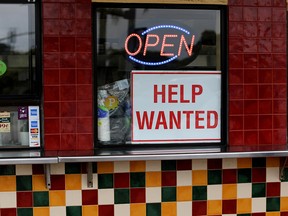Expect interest rates to keep rising until this labour market cools

Article content
Canadian employers were seeking to fill a record 1.03 million positions in March, led by a surge in openings at restaurants and hotels, Statistics Canada reported on May 26. Here’s what you need to know.
Advertisement 2
Article content
What happened?
Job vacancies had been on a downward track. Then, as COVID-19 restrictions eased, restaurants and hotels started making plans for the summer and found it was difficult to lure staff back. Vacancies in the accommodation and food service industry surged 37 per cent to 158,1000 positions at the beginning of March. The vacancy rate, which measures the percentage of total positions that are unfilled, in the hotel and restaurant sector was 12.8 per cent, the highest among the 20 industry groups that Statistics Canada monitors.
The overall vacancy rate was 5.9 per cent, matching the previous peak in September. There were about 988,000 vacancies that month, which was the previous record. Vacancies had dropped to about 826,000 in February, suggesting that labour markets were loosening. Maybe not.
Advertisement 3
Article content
Why does it matter?
Vacancy data will play a big role in determining how aggressively the Bank of Canada raises interest rates to cool inflation, because it offers a window on the extent to which supply and demand are rebalancing. Bank of Canada governor Tiff Macklem last month said he thought a soft landing was possible because employers might adjust to higher interest rates by cutting unfilled positions, rather than reducing actual payrolls.
If vacancies do start to fall, policymakers could be persuaded to take a gentler path to a higher interest-rate setting. If vacancy rates stay high, central bankers might accelerate their interest-rate increases, since the mismatch between supply and demand likely will put upward pressure on wages, which would in turn fuel inflation.
Advertisement 4
Article content
Stephen Poloz, the previous central bank governor, recently said the labour market will be the best source for data on where the economy and interest rates are headed. “Until the job vacancies come down to a more normal level, we’ll know there is excess demand in the labour market,” he said on the latest episode of the C.D. Howe Institute’s podcast. “That’s where homegrown inflation is likely to emerge.”
Is ‘homegrown inflation’ emerging?
Average weekly earnings increased 4.3 per cent in March, to $1,169.69, from a year earlier, compared with a year-over-year increase of 2.1 per cent in February. Excluding the pandemic, which skewed the data, it was the biggest increase since January 2011.
But pay increases of that size might still not be enough to satisfy workers. The consumer price index increased 6.7 per cent in March (and 6.8 per cent in April), suggesting the cost of living is rising faster than wages. That means workers could demand higher pay, and with talent scarce, the odds would be good that they could find someone willing to pay them what they want. Those employers would then feel pressure to raise their prices to compensate for higher wage costs, reinforcing inflationary pressures.
Advertisement 5
Article content
Is the data reliable?
Statistics Canada collects vacancy data as it surveys employers’ payrolls, so statisticians are going directly to the source. That means it is probably more reliable than the agency’s Labour Force Survey (LFS), which relies on household interviews and is published with a large margin of error. However, the LFS is more timely, because it is released with a lag of only a month. (The April LFS showed the jobless rate dropped to a record 5.2 per cent.)
It’s also important to note that the vacancy data doesn’t have a long history, as the dataset dates to October 2020, and the figures aren’t seasonally adjusted. Statistics Canada recognizes the latter is a shortcoming and said in its latest report that it’s working on smoothing the data to reflect natural fluctuations that come with seasonal employment. The agency said experimental vacancy data that accounts for seasonality show vacancies increased from September to December 2021, then decreased in January and February before increasing again in March.
Advertisement 6
Article content
-

Canadian inflation rises to 6.8%: What you need to know
-

Inez Jabalpurwala: Long COVID contributing to brain health crisis disrupting labour force, economy
-

‘We’re finally having our turn’: Boom times are back in Alberta
What’s the bottom line?
The prospect of a summer free of COVID-19 restrictions appears to have ignited more demand than companies can handle with existing staffing levels. That will put upward pressure on wages, which will put upward pressure on inflation. Expect another half-point rate increase by the Bank of Canada next week, and additional interest-rate lifts until policymakers see solid evidence that the labour market is cooling.
Email: kcarmichael@postmedia.com | Twitter: carmichaelkevin


